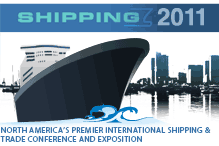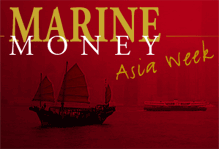
Misperception
We have recently been criticized for our recent coverage of DryShips and it may be deserved. Rightly or wrongly, we have viewed the purchase of shares as an investment and expect a duty of care by management. But what if we have it wrong. We recently heard a story about a tradesman who by his own admission knows little about shipping but has done extremely well in the market by alternately buying and shorting DryShips. If it is just a trade, Mr. Economou has provided the market with an ideal vehicle.
Continue Reading
Out of Favor
Last week, The Wall Street Journal provided another indicator of the shipping slump when they announced the Best on the Street analysts for 2008. Unlike last year, our shipping analysts were conspicuously absent, although the number three slot was taken by Jim Corridore of Standard & Poors, who had rated Horizon Lines a sell during the period in October when the shares fell 77%.
Deep Science or Voodoo
Last week Dennis Berman, in an article entitled “One Key Number in Pricing a Deal: the 52-Week High,”1 laid bare the science of pricing an M&A deal. He reported on a study by Harvard Business School’s Malcolm Baker et. al., which concluded that psychology plays a major role in pricing deals. “In particular, it is one number, the 52-week high for a company’s stock, that matters most…The 52-week high stock price has always had a fetishistic role in merger discussions. By custom, boards are insulted if a merger offer doesn’t breach this price level. Banker presentations focus on whether an offer is greater or lower than the 52-week high.”
So, although one would expect pricing of transactions to vary widely depending on the methodologies and assumptions used to calculate the future value of the target, they do not. In analyzing 7,500 transactions from 1984 to 2007, the authors of the study determined that the data, in fact, is not widely distributed but is closely correlated to the 52-week high. Specifically, they noted that more deals priced at exactly the 52-week high than at any other price and about 60% of the transactions price above that marker. Six Sigma Greenbelts rejoice.
Continue Reading
DRYS Cancels
Yesterday, DryShips announced that it had entered into an agreement to cancel Hull 2089, a Capesize vessel under construction in South Korea. The vessel was contracted for $114 million. Under the terms of the agreements, DryShips will pay a total cancellation penalty of $42.8 million inclusive of its previously paid 20% deposit. The company will end up paying an incremental $20 million and benefits from a reduction of $71.2 million in 2009 capex.
Differentiating Lenders
Just as banks need to know their clients, borrowers also need to evaluate their lenders. Further to an earlier announcement Rickmers Maritime announced last Friday that one of its lending banks has continued to invoke the market disruption clause in one of its loans. This action reflects the bank’s belief that LIBOR does not accurately reflect its cost of funding and has no relation on the creditworthiness of the borrower. The net effect, an increase in interest cost of approximately $37,500 for the current fixing period is not material but it is telling that none of Rickmer’s other nine banks have invoked the clause.
DOF Bond
Despite increasing default rates, corporate issuance of bonds in the primary market has been increasing in Norway and this activity has been extended to high yield, which now represents about 5% of total corporate issuance. For perspective, total issuance of corporates year to date amounts to NOK 19.2 billion compared to NOK 14.6 billion for the full year 2008.
This week Nordea Markets and Pareto Securities brought to market a 2-year senior secured floating rate note for DOF ASA, a leading offshore company, which operates 70 vessels. The notes bear interest at NIBOR + 9% and are secured by a first priority pledge in the shares of Norskan AS, DOF’s Brazilian subsidiary. Norskan owns 12 vessels all of which operate in Brazil with top-rated blue chip counterparties. The pledge provides strong collateral coverage as the outstanding amount under the issuance represents less than 50% of the NAV of the pledged assets. More details on the structure are contained here in the Guts of the Deal table.
Continue Reading
Has Mr. Fredriksen Tapped Out the Banks?
On Tuesday, Seadrill announced that it had secured commitments for a senior secured credit facility in the amount $1.5 billion from a group of commercial lending institutions and export credit agencies.
The proceeds will be used to refinance the existing $1.0 billion bridge loan facility with the excess, a mere $500 million, to be utilized for general corporate purposes. The facility will be secured by 1st priority mortgages on two ultra-deepwater semi-submersible drilling rigs, one deepwater drillship and one jack-up rig.
What about Fixed Price Long-Term Supply Contract for Oil?
By Matthew Flynn
Students of shipbuilding will be aware of the fact that as in most heavy industries, shipbuilding prices very rarely dip below variable costs. Variable costs for a shipbuilder are steel, equipment and direct labour hours, plus miscellaneous project related costs such as Refund Guarantees. Fixed costs are financial costs such as depreciation, overhead allocation and interest payments (or just “sunk costs” to put it bluntly). When the market is bad, the builder can choose to forego recovery of fixed costs, but they tend to refuse a project if it doesn’t even cover variable costs. There are some occasions where builders choose to undertake a project so the yard can be kept as a going-concern (labour redundancy has high costs too), particularly if there is hope of a rebound, but this suboperating cost experience won’t take place on sustainable basis so for our purposes such cases can practically be ignored. We maintain that variable costs form the natural bottom for newbuilding prices – it is the marginal cost of the shipbuilder.
On the contrary, prices for second hand vessels do not have to have anything to do with cost of construction or operation. It is decided strictly on a willing seller and willing buyer basis. Under cashflow pressure or in liquidation, when a seller can be more than willing, there is really no floor other than scrap value. There are costs associated with maintaining the asset (even for cold lay-up!), so the net value for an asset can even be negative if there is no productive deployment in sight (many buildings in Bangkok had negative value in the midst of the Asian financial crisis in 97). Continue Reading
An Update on Stimulus Packages
Over the past year, the massive economic stimulus packages put together by policymakers around the globe have been grabbing the headlines, most notably from the United States, China and Japan. According to the latest estimates from IMF, Asian governments have pledged to pump over USD 950 billion into their economies through increased expenditure, tax cuts and cash hand-outs. And if we look closer at the figures, we would notice that fiscal stimulus in Asia is larger than other parts of the world. China, Japan, Singapore, South Korea, Taiwan and Malaysia have all announced fiscal packages of more than 4% of GDP, twice as large as US’s stimulus this year.
Many governments in Asia have come up with plans to lend a helping hand to the shipping or shipbuilding industry – sectors that they consider to pivotal to their country’s economic well being. Continue Reading
Even Landesbanks Get the Blues
In a report dated May 6, 2009, Standard & Poor’s (“S&P”) took a hard look at the six rated German Landesbanks in light of a deteriorating economic outlook and the impact that it will have both on asset quality and short to medium term business prospects, as well as the challenges these banks face to their funding capacity and capital requirements in a fundamentally changing banking environment. Their conclusions led to the downgrading of five institutions by one notch and revising the outlook on the other, Heleba, to negative (see table).







